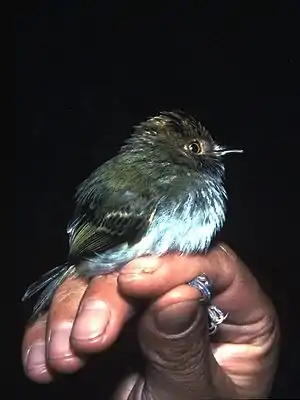Rot-Schuppenkopftyrann
Der Rot-Schuppenkopftyrann[1] (Lophotriccus pileatus) ist ein Singvogel aus der Familie der Tyrannen. Er ist in fünf Unterarten in Mittel- und Südamerika beheimatet.
| Rot-Schuppenkopftyrann | ||||||||||||
|---|---|---|---|---|---|---|---|---|---|---|---|---|

Rot-Schuppenkopftyrann (Lophotriccus pileatus) | ||||||||||||
| Systematik | ||||||||||||
| ||||||||||||
| Wissenschaftlicher Name | ||||||||||||
| Lophotriccus pileatus | ||||||||||||
| (Tschudi, 1844) |
Merkmale
Der Rot-Schuppenkopftyrann erreicht eine Körperlänge von 10 cm. Der Rücken ist vorwiegend olivfarben, die Unterseite weißlich bis blassgelb. Der vordere Oberkopf ist braun, der Gesichtsbereich gelblichbraun. Die Federn der üblicherweise nicht aufgerichteten Haube sind, auch angelegt erkennbar, an der Spitze rötlichbraun. Flügel und Schwanz sind dunkel, die Flügel mit zwei gelblichen Flügelbinden. Brust und Kehle sind dunkel-olivfarben gestreift.[2][3]
Verbreitung und Lebensraum
Der Rot-Schuppenkopftyrann kommt von Costa Rica bis zum nördlichen Venezuela und bis in das südliche Peru vor. Meist ist er in Höhen von 600 bis 1200 m zu finden und bewohnt primäre Regenwälder, Sekundärwald und Waldränder.[3]
Lebensweise
Der Rot-Schuppenkopftyrann ernährt sich hauptsächlich von Insekten.[3]
Unterarten
Folgende fünf Unterarten werden unterschieden:[4]
- Lophotriccus pileatus hypochlorus Berlepsch & Stolzmann, 1906[5] – Peru.[1]
- Lophotriccus pileatus luteiventris Taczanowski, 1884[6] – Honduras, Costa Rica, Panama.[1]
- Lophotriccus pileatus pileatus (Tschudi, 1844)[7]– Anden, Ecuador bis Peru.[1]
- Lophotriccus pileatus santaeluciae Todd, 1952[8] – Venezuela, Kolumbien.[1]
- Lophotriccus pileatus squamaecrista (Lafresnaye, 1846)[9] – Anden, Kolumbien und Ecuador.[1]
Literatur
- Johann Jakob von Tschudi: Avium conspectus quae in Republica Peruana repiuntur et pleraque observatae vel collectae sunt in itinere. In: Archiv für Naturgeschichte. Band 10, Nr. 1, 1844, S. 262–317 (biodiversitylibrary.org).
- Hans Hermann Carl Ludwig von Berlepsch, Jan Sztolcman: Rapport sur les nouvelles collections ornithologiques faites au Pérou par M. Jean Kalinowski. In: Ornis; internationale Zeitschrift für die gesammte Ornithologie. Band 13, Nr. 2, 1906, S. 63–133 (biodiversitylibrary.org).
- Frédéric de Lafresnaye: Essai d'une monographie du genre Todirostre de Lesson /Traité d'ornit. In: Revue zoologique par la Société cuviérienne. Band 9, 1846, S. 360–365 (biodiversitylibrary.org).
- Walter Edmond Clyde Todd: New tyrant flycatchers from South America. In: Annals of the Carnegie Museum. Band 32, Nr. 5, 1952, S. 291–304 (biodiversitylibrary.org).
- Władysław Taczanowski: Ornithologie du Pérou. Band 2. Typographie Oberthur, Rennes 1884 (biodiversitylibrary.org).
Quellen
- Videos, Fotos und Tonaufnahmen zu Lophotriccus pileatus in der Internet Bird Collection
- Robert S. Ridgely, Guy Tudor, William L. Brown: The Birds of South America: Vol. II, the Suboscine Passerines. University of Texas Press, 1994, ISBN 978-0-292-77063-8, S. 510.
- Robert S. Ridgely, John A. Gwynne: A Guide to the Birds of Panama with Costa Rica, Nicaragua, and Honduras. Princeton University Press, 1992, ISBN 978-0-691-02512-4, S. 291.
- ITIS Report Lophotriccus pileatus (abgerufen am 13. Juni 2011)
- Hans Hermann Carl Ludwig von Berlepsch u. a. (1906), S. 85.
- Władysław Taczanowski (1884), S. 231.
- Johann Jakob von Tschudi (1844), S. 273.
- Walter Edmond Clyde Todd, S. 299.
- Frédéric de Lafresnaye (1844), S. 363.
Weblinks
- Lophotriccus pileatus in der Roten Liste gefährdeter Arten der IUCN 2010.4. Eingestellt von: BirdLife International, 2009. Abgerufen am 10. Juni 2011.